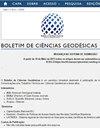A NEW PERSPECTIVE FOR PHYSICAL HEIGHTS IN BRAZIL
IF 0.5
Q3 Earth and Planetary Sciences
引用次数: 3
Abstract
Abstract The physical heights definition of heights, proposed by Helmert in 1890 is one of the commonly used heights systems in practice. In Helmert’s definition, the mean value of gravity along plumbline is computed by simplifying the topography with a Bouguer shell containing masses with mean density value. Although this approximation might be accurate enough many purposes, a more rigorous definition can be determined by considering the effects of terrain, topographic mass density variation, and masses contained in the geoid the mean gravity value along the plumbline. The purpose of this paper is to compute the corrections for the Helmert’s definition of the orthometric heights to obtain the rigorous orthometric heights in the state of São Paulo and adjacent states and to evaluate these corrections. The heights system used in Brazil (until July 2018) and some South American countries is normal-orthometric heights, therefore the corrections needs to be applied accordingly. Our numerical results show that there are significant differences between the normal-orthometric and rigorous orthometric heights, with maximum values of ~ 0.4 m, minimum of ~ -0.8 m and mean value of ~ -0.32 m. There are larger differences between normal-orthometric and normal height than the ones between normal and rigorous definition of orthometric heights.巴西人身高的新视角
Helmert于1890年提出的物理高度定义是实践中常用的高度系统之一。在Helmert的定义中,重力沿铅垂线的平均值是通过用含有密度平均值的质量的布格壳简化地形来计算的。虽然这种近似在许多情况下可能足够精确,但可以通过考虑地形、地形质量密度变化和大地水准面中包含的质量(沿铅垂线的平均重力值)的影响来确定更严格的定义。本文的目的是计算Helmert定义的正测高度的校正,以获得圣保罗州和邻近州的严格正测高度,并对这些校正进行评估。巴西(直到2018年7月)和一些南美国家使用的高度系统是标准正交高度,因此需要相应地进行校正。数值结果表明,正正交高度与严格正交高度之间存在显著差异,最大值为~ 0.4 m,最小值为~ -0.8 m,平均值为~ -0.32 m。正正交高度与正正交高度之间的差异大于正正交高度与严格定义的正正交高度之间的差异。
本文章由计算机程序翻译,如有差异,请以英文原文为准。
求助全文
约1分钟内获得全文
求助全文
来源期刊

Boletim De Ciencias Geodesicas
Earth and Planetary Sciences-General Earth and Planetary Sciences
CiteScore
1.70
自引率
20.00%
发文量
10
审稿时长
3 months
期刊介绍:
The Boletim de Ciências Geodésicas publishes original papers in the area of Geodetic Sciences and correlated ones (Geodesy, Photogrammetry and Remote Sensing, Cartography and Geographic Information Systems).
Submitted articles must be unpublished, and should not be under consideration for publication in any other journal. Previous publication of the paper in conference proceedings would not violate the originality requirements. Articles must be written preferably in English language.
 求助内容:
求助内容: 应助结果提醒方式:
应助结果提醒方式:


